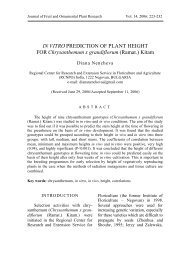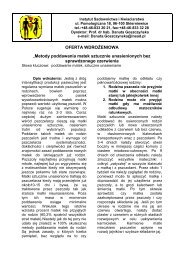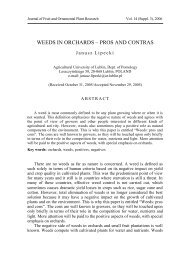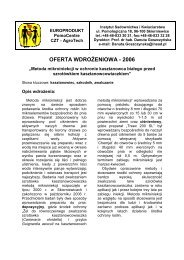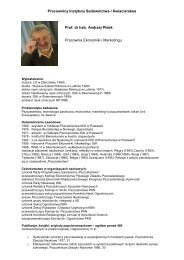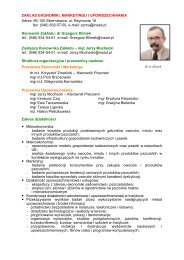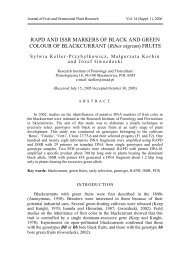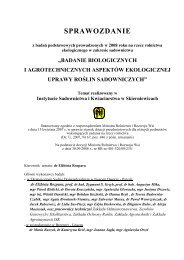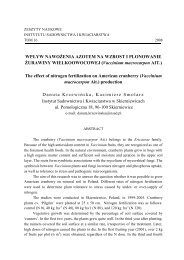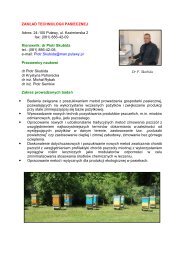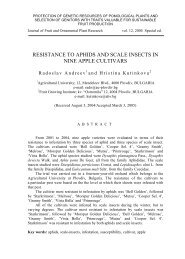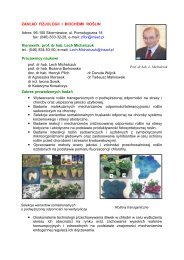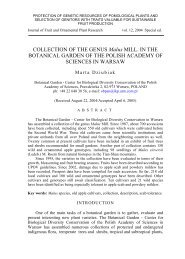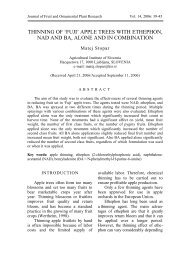You also want an ePaper? Increase the reach of your titles
YUMPU automatically turns print PDFs into web optimized ePapers that Google loves.
Journal of Fruit and Ornamental Plant Research Vol. 18(2) 2010: 161-167<br />
PRELIMINARY EVALUATION OF THE GROWTH AND<br />
YIELD OF FOUR JAPANESE PLUM CULTIVARS<br />
(<strong>Prunus</strong> <strong>salicina</strong> <strong>Lindl</strong>.) GRAFTED ON WANGENHEIM<br />
PRUNE SEEDLINGS<br />
Ireneusz Sosna and Daria Kortylewska<br />
Wrocław University of Environmental and Life Sciences<br />
Pl. Grunwaldzki 24a, 50-363 Wrocław, POLAND<br />
(Received September 13, 2010/Accepted October 26, 2010)<br />
A B S T R A C T<br />
Japanese plum trees of the cultivars ‘Kometa’, ‘Najdiena’, ‘Skoropłodnaja’ and<br />
‘Shiro’ grafted on Wangenheim Prune seedlings, were planted in the spring of 2006 at<br />
the Fruit Experimental Station in Samotwór near Wrocław, Poland. As the control,<br />
trees of the ‘Amers’ cultivar, which belong to European plums, were used. All trees<br />
were planted at a spacing of 4.0 x 2.0 m (1250 trees per hectare). The experiment was<br />
established in a randomized block design, in four replications, with 5 trees per plot. In<br />
2006-2009, records of vegetative growth, abundance of blooming, yield, and fruit<br />
weight were taken.<br />
The first significant yield was achieved in the third year after planting. In 2008-<br />
2009 trees of ‘Shiro’ had an abundant yield (48.5 kg∙tree -1 ). ‘Shiro’ produced a significantly<br />
higher yield compared to other cultivars. There were no significant differences<br />
between ‘Amers’ (27.3 kg∙tree -1 ) and the Japanese plum cultivars ‘Kometa’<br />
(29.2 kg∙tree -1 ) and ‘Skoropłodnaja’ (21.5 kg∙tree -1 ). Japanese plum fruits were significantly<br />
smaller compared to the European ones. The cultivar ‘Amers’ had the<br />
heaviest fruit (53 g). The Japanese plum trees had smaller fruits, and among the them,<br />
the cultivar ‘Shiro’ had the largest fruit (44 g). The observations showed that ‘Shiro’<br />
produced higher yields, gave large fruits, and had intensive blooming, but the growth<br />
of the trees was very strong.<br />
Key words: Japanese plum, <strong>Prunus</strong> <strong>salicina</strong>, growth, yield, blooming, weight of fruit<br />
INTRODUCTION<br />
Areas with Japanese plum orchards<br />
are growing rapidly in the<br />
world (Grzyb, 2002). Japanese plums<br />
(<strong>Prunus</strong> <strong>salicina</strong> <strong>Lindl</strong>.) are cultivated<br />
mainly in Japan and China. In<br />
addition to these countries, in the
I. Sosna and D. Kortylewska<br />
United States, especially California,<br />
there are large areas of cultivation;<br />
mainly with the cultivars ‘Larosa’<br />
and ‘Santa Rosa’ (Buler et al., 2006).<br />
Trees of <strong>Prunus</strong> <strong>salicina</strong> are also<br />
grown in South Africa. The fruits are<br />
exported to markets in Europe and<br />
the East Asian. Only cultivars which<br />
are adapted to the 3-4 week shipping<br />
time required to reach the European<br />
and East Asia markets are grown<br />
(Cook, 2007). In Europe, Japanese<br />
plum orchards are found only in the<br />
Mediterranean countries (Rozpara<br />
and Grzyb, 2006). There have also<br />
been attempts to grow Japanese plum<br />
cultivars in other parts of Europe.<br />
Some of the Japanese plums, like<br />
‘Kometa’ and ‘Najdiena’, are hybrids<br />
of <strong>Prunus</strong> <strong>salicina</strong> with Myrobalan<br />
cultivars (Żurawicz, 2003). From<br />
results of the studies conducted in<br />
Hungary, it can be concluded that<br />
Japanese plums begin to blossom<br />
a week earlier than European plums.<br />
They blossom profusely and set<br />
many fruits. There have also been<br />
studies in Poland on the cultivation<br />
of these plums. Cultivars of <strong>Prunus</strong><br />
<strong>salicina</strong> have a higher value than<br />
European ones because they begin to<br />
bear fruit very early and achieve<br />
a high yield. They require hand fruit<br />
thinning, but they are capable of<br />
acclimating to local conditions<br />
(Buler et al., 2006). Advantages of<br />
Japanese plums on the Polish market<br />
are: original appearance and taste,<br />
ability to transport well, and exceptional<br />
durability.<br />
In the production of plum trees in<br />
Poland, the generative rootstock –<br />
Myrobalan (<strong>Prunus</strong> cerasifera var.<br />
162<br />
divaricata) still dominates. Plum<br />
trees are also produced on Wangenheim<br />
Prune seedlings. In terms of<br />
weak tree growth and increased<br />
yield, Wangenheim Prune seedlings<br />
are considered better than Myrobalan<br />
(Sitarek, 2002). The Wangenheim<br />
Prune seedling rootstock improved<br />
fruit weight, with a range of cultivars.<br />
This rootstock also had an effect on<br />
higher yields (Blažek et al., 2005).<br />
The aim of this study was to<br />
make a preliminary estimation of<br />
growth and yield of four Japanese<br />
plum cultivars grafted on Wangenheim<br />
Prune seedlings.<br />
MATERIAL AND METHODS<br />
The experiment was conducted at<br />
the Fruit Experimental Station, in<br />
Samotwór near Wrocław. The paper<br />
presents the results of the first four<br />
years of the trial. The research was<br />
carried out on ‘Kometa’, ‘Najdiena’,<br />
‘Skoropłodnaja’ and ‘Shiro’ Japanese<br />
plum trees grafted on Wangenheim<br />
Prune seedlings. Trees of the<br />
cultivar ‘Amers’, which belong to<br />
European plums, on the same rootstock,<br />
were used as the control. In<br />
spring 2006, one-year old maidens<br />
were planted at a spacing of 4.0 x<br />
2.0 m (1250 trees per hectare). The<br />
experiment was established in a randomized<br />
design in four replications,<br />
with 5 trees per plot. Tree canopies<br />
were kept almost natural, with minimum<br />
pruning only during the summer.<br />
Trees were not irrigated and<br />
fruitlets were annually hand thinned.<br />
From the first year, there was herbicide<br />
fallow in the rows and sward<br />
J. Fruit Ornam. Plant Res. vol. 18(2) 2010: 161-167
etween them. Plant protection was<br />
carried out according to the current<br />
recommendations for plum orchards.<br />
In 2006-2009, records of vegetative<br />
growth, abundance of blooming,<br />
yield, and fruit weight were taken.<br />
Obtained results were statistically<br />
elaborated by multifactorial analysis<br />
of variance. The significance of differences<br />
between means was evaluated<br />
by Duncan’s t-test at p = 0.05.<br />
RESULTS AND DISCUSSION<br />
There were differences between<br />
cultivars in total number of shoots<br />
per tree (Tab. 1). ‘Amers’ and<br />
‘Skoropłodnaja’ had almost the same<br />
total number of shoots, and had the<br />
lowest number of annual shoots.<br />
‘Kometa’ and ‘Shiro’ had a significantly<br />
higher total number of shoots,<br />
respectively. Trees of ‘Najdiena’ had<br />
substantially more annual shoots<br />
compared to the other cultivars. The<br />
cultivar had an influence on the total<br />
length of annual shoots per a tree.<br />
Japanese plums had higher total<br />
length of shoots than the European<br />
plum cultivar ‘Amers’. However,<br />
from among the Japanese plum cultivars,<br />
‘Najdiena’ and ‘Shiro’ had<br />
significantly longer annual shoots.<br />
‘Skoropłodnaja’ had a substantially<br />
higher mean length of shoots. There<br />
were no significant differences in that<br />
respect between the ‘Amers’, ‘Kometa’,<br />
‘Najdiena’ and ‘Shiro’ trees.<br />
Buler et al. (2006) proved that ‘Kometa’<br />
and ‘Najdiena’ tend to produce<br />
spreading crowns with numerous short<br />
shoots. Their crowns are naturally<br />
made up of a long, upright leader with<br />
numerous, weak shoots.<br />
Preliminary evaluation of the growth and yield….<br />
Some differences were observed<br />
in trunk cross-sectional area increment<br />
(TCAI). ‘Najdiena’, ‘Skoropłodnaja’<br />
and ‘Kometa’ had the<br />
smallest TCAI but there was no significant<br />
difference between ‘Kometa’<br />
and ‘Amers’ (Tab. 2). ‘Shiro’ trees<br />
had a significantly higher TCSA.<br />
From the description of ‘Shiro’, it<br />
appears that it grew strong or even<br />
very strong (Grzyb, 2002). Trees of<br />
‘Amers’ grew weakly or medium<br />
strongly. In the experiment conducted<br />
at the Experimental Orchard<br />
in Skierniewice in 1990-1998, important<br />
differences were observed in<br />
TCSA (autumn 1998). In the Skierniewice<br />
experiment, ‘Amers’ on the<br />
Wangenheim Prune seedlings, had<br />
the smallest TCSA (45.4 cm 2 ) compared<br />
to trees of other cultivars on<br />
<strong>Prunus</strong> cerasifera var. divaricata<br />
(Rozpara and Grzyb, 1999).<br />
Blooming intensity depended<br />
heavily on weather conditions<br />
(Tab. 3). A long warm period occurred<br />
in January 2006/2007, then by<br />
February, the temperature dropped to<br />
about -15 ºC. The result was frozen<br />
flower buds. As a consequence, in<br />
spring 2007, only single flowers appeared<br />
on trees of the studied cultivars.<br />
There were some differences in blooming<br />
intensity. In spring 2008, Japanese<br />
plums blossomed significantly better<br />
than ‘Amers’. The next year, ‘Kometa’<br />
had the least amount of blossoms.<br />
The tested varieties gave the first<br />
substantial crop in the third growing<br />
season after planting (Tab. 4). Buler<br />
et al. (2006), observed Japanese<br />
plum trees which started bearing in<br />
J. Fruit Ornam. Plant Res. vol. 18(2) 2010: 161-167 163
I. Sosna and D. Kortylewska<br />
Table 1. Number and length of annual shoots<br />
164<br />
Cultivar<br />
Total number of<br />
shoots per tree<br />
(2006-2008)<br />
Total length of<br />
shoots (2006-<br />
2008)<br />
[cm tree -1 ]<br />
Mean shoot<br />
length [cm]<br />
Amers 95.4 a* 2851 a 29.9 a<br />
Kometa 130.7 b 4044 b 30.9 a<br />
Najdiena 201.6 d 5450 c 27.0 a<br />
Skoropłodnaja 92.5 a 4061 b 43.9 b<br />
Shiro 183.2 c 5652 c 30.9 a<br />
*Means followed by the same letter do not differ at p = 0.05 according to Duncan’s multiple range t-test<br />
Table 2. Trunk cross-sectional area (TCSA) and crop efficiency index (CEC)<br />
Cultivar<br />
TCSA<br />
autumn 2009<br />
[cm 2 ]<br />
TCSA increment<br />
2007-2009<br />
[cm 2 ]<br />
CEC<br />
2006-2009<br />
[kg cm -2 ]<br />
Amers 24.8 b* 15.0 b 1.10 a<br />
Kometa 23.5 b 12.7 ab 1.24 a<br />
Najdiena 21.3 ab 11.5 a 1.56 b<br />
Skoropłodnaja 18.0 a 10.5 a 1.19 a<br />
Shiro 37.5 c 22.2 c 1.29 a<br />
*Explanations, see Table 1<br />
Table 3. Blooming intensity on a 0-5 scale (0 – tree without flowers; 5 – very abundant<br />
blooming tree)<br />
Cultivar 2007 2008 2009<br />
Amers 0.0 a* 3.4 a 4.0 b<br />
Kometa 1.1 c 4.6 c 3.2 a<br />
Najdiena 0.3 b 4.7 c 4.4 c<br />
Skoropłodnaja 1.0 c 4.6 c 4.7 c<br />
Shiro 1.0 c 4.0 b 4.5 c<br />
*Explanations, see Table 1<br />
Table 4. Yield and mean fruit weight<br />
Cultivar<br />
Yield [kg tree - 1 ]<br />
2008 2009<br />
Cumulative<br />
yield<br />
2008-2009<br />
[kg tree - 1 ]<br />
Mean fruit<br />
weight<br />
2008-2009<br />
[g]<br />
Amers 8.7 b* 18.6 ab 27.3 ab 53 d<br />
Kometa 10.0 bc 19.2 ab 29.2 ab 33 b<br />
Najdiena 8.0 b 25.2 b 33.2 b 27 a<br />
Skoropłodnaja 3.9 a 17.6 a 21.5 a 25 a<br />
Shiro 12.2 c 36.3 c 48.5 c 44 c<br />
*Explanations, see Table 1<br />
J. Fruit Ornam. Plant Res. vol. 18(2) 2010: 161-167
the second growing season. In the<br />
first year of cropping, there were no<br />
significant differences in the level of<br />
the yield of the plum trees: ‘Amers’,<br />
‘Kometa’ and ‘Najdiena’. The yield<br />
per tree of ‘Skoropłodnaja’ was substantially<br />
lower than the yield per<br />
tree of the European plums. ‘Shiro’<br />
obtained the highest yield per tree<br />
(12.2 kg). In the experiment of Buler<br />
et al. (2006) the first crop of <strong>Prunus</strong><br />
<strong>salicina</strong> was higher than in the European<br />
plum cultivars. In our experiment,<br />
the level of the yield of ‘Kometa’<br />
and ‘Najdiena’, in the third<br />
year after planting, was similar to<br />
that obtained in the experiment conducted<br />
by Buler et al. (2006).<br />
In the second year of cropping,<br />
yield per tree was significantly lower<br />
in the cultivars ‘Skoropłodnaja’, ‘Amers’,<br />
Najdiena’ and ‘Kometa’. The<br />
yield per tree of ‘Amers’, ‘Kometa’<br />
and ‘Najdiena’, however, were not<br />
significanty different. ‘Shiro’ trees<br />
were heavily cropping (36.3 kg∙tree -1 ).<br />
Important differences were observed<br />
in cumulative yield. Trees of<br />
‘Shiro’ were characterized by the<br />
highest production in the first four<br />
years after planting (48.5 kg∙tree -1 ).<br />
‘Skoropłodnaja’, ‘Kometa’ and ‘Amers’<br />
had a significantly lower cumulative<br />
yield. Cultivars ‘Amers’, ‘Kometa’<br />
and ‘Najdiena’ were cropping<br />
on the same level. ‘Amers’ was<br />
counted among the group of the best<br />
yielding plum trees in the first year<br />
of fruiting (Rozpara et al., 2000).<br />
Grzyb (2002) states that ‘Shiro’ and<br />
‘Kometa’ yield a good crop.<br />
In spite of fruit thinning, Japanese<br />
plums formed smaller fruits<br />
Preliminary evaluation of the growth and yield….<br />
compared to European plums, in this<br />
experiment. ‘Skoropłodnaja’ and ‘Najdiena’<br />
produced fruit which were of<br />
similar weight (25 and 27 g), respectively.<br />
Fruit of ‘Skoropłodnaja’ and<br />
‘Najdiena’ were significantly lighter<br />
than fruit of other cultivars. Among<br />
the Japanese plums, ‘Shiro’ had the<br />
heaviest fruits (44 g). But according<br />
to Grzyb (2002), mean fruit weight<br />
for this cultivar is 35 grams. ‘Amers’<br />
had the highest mean fruit weight (53<br />
g). Similar results were obtained by<br />
Grzyb and Sitarek (2003) on ‘Amers’<br />
(52.3 g), however their trees were<br />
grafted on seedlings of <strong>Prunus</strong> cerasifera<br />
var. divaricata Led. Fruit<br />
weight of about 30 grams is optimal<br />
for ‘Kometa’ and ‘Najdiena’ (Buler<br />
et al., 2006).<br />
REFERENCES<br />
Blažek J., Vávra R., Hlušičová I. 2005.<br />
Fruit evaluation of new plum cultivars<br />
in a trial at Holovousy in 2000-<br />
2004. VĚDECKÉ PRÁCE<br />
OVOCNÁŘSKÉ 19: 7-22.<br />
Buler Z., Mika A., Krzewińska D., Treder<br />
W., Sopyła B. 2006. Effect of<br />
three training systems and hand<br />
fruitlet thinning on yield and fruit<br />
quality in two cultivars of Japanese<br />
plum (<strong>Prunus</strong> <strong>salicina</strong> <strong>Lindl</strong>.). J.<br />
FRUIT ORNAM. PLANT RES. 14:<br />
125-134.<br />
Cook N.C. 2007. An overview of plum<br />
training systems in South Africa.<br />
ACTA HORT. 732: 435-438.<br />
Grzyb Z. 2002. Nowe odmiany śliw do<br />
uprawy w Polsce. VII Ogólnopolskie<br />
Spotkanie Sadowników w Grójcu,16-<br />
17 stycznia 2002, pp. 121-130.<br />
Grzyb Z.S., Sitarek M. 2003. The effect<br />
of training systems and planting den-<br />
J. Fruit Ornam. Plant Res. vol. 18(2) 2010: 161-167 165
I. Sosna and D. Kortylewska<br />
sity on growth and fruiting of plum<br />
trees budded on divaricata prune<br />
seedling rootstock. FOLIA HORT.<br />
15/1: 69-74.<br />
Rozpara E., Grzyb Z.S. 1999. Odmiany<br />
śliw i czereśni do nowoczesnych sadów.<br />
IV Ogólnopolskie Spotkanie<br />
Sadowników w Grójcu, 20-21 stycznia<br />
1999, pp. 14-20.<br />
Rozpara E., Grzyb Z.S. 2006. Wzrost<br />
i owocowanie kilku odmian śliwy japońskiej<br />
w warunkach Polski centralnej.<br />
XLIV Ogólnopolska Naukowa<br />
Konferencja Sadownicza. Skierniewice,<br />
30-31 sierpnia 2006, pp. 56-57.<br />
166<br />
Rozpara E., Grzyb Z.S., Omiecińska B.,<br />
Berczyński S., StańA. 2000. Wstępne<br />
wyniki oceny nowych odmian<br />
śliwy z uwzględnieniem ich podatności<br />
na choroby. XXXIX Ogólnopolska<br />
Naukowa Konferencja Sadownicza.<br />
Skierniewice, 29-31 sierpnia<br />
2000, pp. 66-67.<br />
Sitarek M. 2002. Wegetatywne podkładki<br />
dla śliw w świetle badańISK. VII<br />
Ogólnopolskie Spotkanie Sadowników<br />
w Grójcu, 16-17 stycznia 2002,<br />
pp. 131-138.<br />
Żurawicz E. 2003. Pomologia – odmianoznawstwo<br />
roślin sadowniczych –<br />
aneks. PWRiL, Warszawa, 122-125 p.<br />
WSTĘPNE WYNIKI OCENY WZROSTU<br />
I PLONOWANIA CZTERECH ODMIAN ŚLIWY<br />
JAPOŃSKIEJ (<strong>Prunus</strong> <strong>salicina</strong> <strong>Lindl</strong>.) ZASZCZEPIONYCH<br />
NA SIEWKACH WĘGIERKI WANGENHEIMA<br />
Ireneusz Sosna i Daria Kortylewska<br />
S T R E S Z C Z E N I E<br />
Doświadczenie prowadzono w Stacji Doświadczalnej Uniwersytetu Przyrodniczego<br />
w Samotworze koło Wrocławia. Wiosną2006 roku posadzono jednoroczne<br />
okulanty śliwy japońskiej odmian ‘Kometa’, ‘Najdiena’, ‘Skoropłodnaja’ i ‘Shiro’ na<br />
podkładce Węgierka Wangenheima. Jako odmiany kontrolnej użyto europejskiej<br />
śliwy – ‘Amers’, równieżzaszczepionej na tej samej podkładce. Drzewa prowadzono<br />
w formie korony prawie naturalnej z minimalnym cięciem w okresie letnim w rozstawie<br />
4,0 x 2,0 m (1250 drzew∙ha -1 ). Doświadczenie założono metodąlosowanych<br />
bloków, w czterech powtórzeniach, po 5 drzew na każdym poletku doświadczalnym.<br />
Celem badańbyła ocena wzrostu, kwitnienia, plonowania i jakości owoców śliwy<br />
japońskiej w pierwszych czterech latach prowadzenia doświadczenia.<br />
Badane odmiany pierwszy istotny plon wydały w trzecim roku po posadzeniu.<br />
W latach 2008-2009 najobficiej plonowała odmiana ‘Shiro’ (48,5 kg∙drzewo -1 ), dając<br />
istotnie wyższy plon w porównaniu z pozostałymi odmianami. Nie wykazano różnic<br />
J. Fruit Ornam. Plant Res. vol. 18(2) 2010: 161-167
Preliminary evaluation of the growth and yield….<br />
statystycznych między odmianąkontrolną‘Amers’ (27,3 kg∙drzewo - 1 ) a odmianami<br />
śliwy japońskiej ‘Najdiena’ (33,2 kg∙drzewo -1 ), ‘Kometa’ (29,2 kg∙drzewo -1 ) i ‘Skoropłodnaja’<br />
(21,5 kg∙drzewo -1 ). Śliwy japońskie wytwarzały istotnie mniejsze owoce<br />
w porównaniu ze śliwami europejskimi. Masa owocu odmiany ‘Amers’ wynosiła<br />
53 g, natomiast owoce odmian śliwy japońskiej uzyskiwały masęw granicach od 25 g<br />
do 44 g, wśród których największe miała odmiana ‘Shiro’. Różnice między odmianami<br />
występowały teżw sile wzrostu drzew mierzonej polem przekroju poprzecznego<br />
pnia. W latach 2007-2009 najsilniej rosły drzewa odmiany ‘Shiro’ (22,2 cm 2 ). Drzewa<br />
odmiany ‘Skoropłodnaja’ charakteryzowały sięsłabszym wzrostem niżdrzewa<br />
odmiany ‘Amers’ (15,0 cm 2 ). Intensywnośćkwitnienia zależała w dużej mierze od<br />
warunków pogodowych. W 2007 roku odmiany bardzo słabo kwitły, a odmiana<br />
‘Amers’ nie rozwinęła żadnych kwiatów. Analizując lata 2008-2009 zauważono, że<br />
odmiany śliwy japońskiej charakteryzowały sięwyższąintensywnościąkwitnienia niż<br />
odmiana kontrolna. Z obserwacji wynika, że odmiana ‘Shiro’ obficie owocowała<br />
wytwarzając dośćduże owoce. Jednak drzewa tej śliwy rosły bardzo silnie. Odmiany<br />
‘Kometa’, ‘Najdiena’ i ‘Skoropłodnaja’ plonowały porównywalnie z odmianąeuropejską,<br />
chociażwytwarzały drobne owoce. Charakteryzowały sięsłabszym wzrostem<br />
i intensywniejszym kwitnieniem niżdrzewa odmiany ‘Amers’.<br />
Słowa kluczowe: śliwa japońska, <strong>Prunus</strong> <strong>salicina</strong>, wzrost, plon, kwitnienie, masa<br />
owocu<br />
J. Fruit Ornam. Plant Res. vol. 18(2) 2010: 161-167 167



